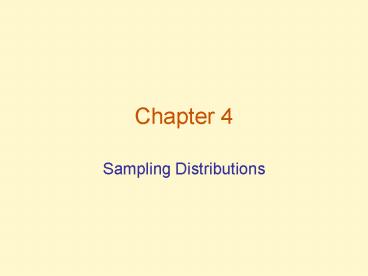Sampling Distributions - PowerPoint PPT Presentation
1 / 16
Title: Sampling Distributions
1
Chapter 4
- Sampling Distributions
2
The Concept of Sampling Distributions
- Parameter numerical descriptive measure of a
population. It is usually unknown - Sample Statistic - numerical descriptive measure
of a sample. It is usually known - Sampling distribution the probability
distribution of a sample statistic, calculated
from a very large number of samples of size n
3
The Concept of Sampling Distributions
- 19, 19, 20, 21, 20, 25, 22, 18, 18, 17
- We can take 45 samples of size 2 from this group
of 10 observations - 19.9
- If we take one random sample and get (19, 20),
- Another random sample may yield (22, 25), with
4
The Concept of Sampling Distributions
- Taking all possible samples of size 2, we can
graph them and come up with a sampling
distribution of the sample statistic - Sampling distributions can be derived for any
statistic - Knowing the properties of the underlying sampling
distributions allows us to judge how accurate the
statistics are as estimates of parameters
5
The Concept of Sampling Distributions
- Decisions about which sample statistic to use
must take into account the sampling distribution
of the statistics you will be choosing from.
6
The Concept of Sampling Distributions
- Given the probability distribution
- Find the sampling distribution of mean and median
of x
X 0 6 9
p(x) 1/3 1/3 1/3
7
(No Transcript)
8
The Concept of Sampling Distributions
- Simulating a Sampling Distribution
- Use a software package to generate samples of
size n 11 from a population with a known ? .5 - Calculate the mean and median for each sample
- Generate histograms for the means and medians of
the samples - Note the greater clustering ofthe values of
around ? - These histograms are approximations of the
sampling distributions of and m
9
Properties of Sampling Distributions
Unbiasedness and Minimum Variance
- Point Estimator formula or rule for using
sample data to calculate an estimate of a
population parameter - Point estimators have sampling distributions
- These sampling distributions tell us how accurate
an estimate the point estimator is likely to be - Sampling distributions can also indicate whether
an estimator is likely to under/over estimate a
parameter
10
Properties of Sampling Distributions
Unbiasedness and Minimum Variance
- Two point estimators, A and B, of parameter ?
- After generating the sampling distributions of A
and B, we can see that - A is an unbiased estimator of ?
- B is a biased estimator of ?, with a bias toward
overstatement
11
Properties of Sampling Distributions
Unbiasedness and Minimum Variance
- What if A and B are both unbiased estimators of
?? - Look at the sampling distributions and compare
their standard deviations - A has a smaller standard deviation than B
- Which would you use as your estimator?
12
The Sampling Distribution of X and the Central
Limit Theorem
- Assume 1000 samples of size n taken from a
population, with calculated for each sample.
What are the Properties of the Sampling
Distribution of ? - Mean of sampling distribution equals mean of
sampled population - Standard deviation of sampling distribution
equals - Standard deviation of sampled populationSquare
root of sample size - or,
- is referred to as the standard error of
the mean
13
The Sampling Distribution of X and the Central
Limit Theorem
- If we sample n observations from a normally
distributed population, the sampling distribution
of will be a normal distribution - Central Limit Theorem
- In a population with standard deviation and
mean , the distribution of sample means from
samples of n observations will approach a normal
distribution with standard deviation of
and mean of as n gets larger.
The larger the n, the closer the sampling
distribution of to a normal distribution.
14
The Sampling Distribution of X and the Central
Limit Theorem
- Note how the samplingdistribution approachesthe
normal distributionas n increases, whatever the
shapeof the distribution of theoriginal
population
15
The Sampling Distribution of X and the Central
Limit Theorem
- Assume a population with ? 54, ? 6. If a
sample of 50 is taken from this population, what
is the probability that the sample mean is less
than or equal to 52? - Sketch the curve of x and identify area of
interest
16
The Sampling Distribution of X and the Central
Limit Theorem
- Convert 52 to z value
- First, calculate the standard deviation of the
sampling distribution - Then calculate the z value
- Use the tables to findprobability of interest































